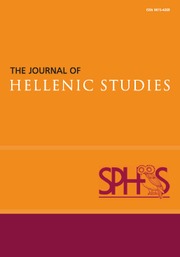No CrossRef data available.
Article contents
Extract
The pottery found hitherto in Cyprus has been for the most part of a rude, local fabric, resembling both in its shapes and system of decoration the pottery of Egypt. The Greek element in the population of Cyprus and the frequent participation of outside Greeks in the affairs of the island might have been expected to leave some decided trace in the pottery. But this expectation had not been realised to any degree till last year, when excavations at Poli tis Chrysokhou brought to light an extensive series of Greek vases and other antiquities. Among the vases were the two here published.
The locality where these antiquities were found is supposed to be that of the ancient Marion, a town on the west coast of Cyprus, of which little is recorded except that it had been taken by an Athenian fleet under Kimon, on which occasion its inhabitants were treated with much clemency, and that subsequently it was destroyed by Ptolemy, on which occasion its inhabitants were removed to Paphos. At that time it was ruled by a prince called Stasioekos.
- Type
- Research Article
- Information
- Copyright
- Copyright © The Society for the Promotion of Hellenic Studies 1887
References
page 317 note 1 See Jahrbuch des Arch. Inst. 1887, p. 85, pl. 8, where the silver girdle now in the British Museum is published.
page 317 note 2 Diodorus Sic. xii. 3–4.
page 317 note 3 Ibid. xix. 79, 4.
page 318 note 1 See Duncker, viii. p. 379.
page 318 note 2 I. 112. He had before said (I. 94) of the Lacedaemonians and Athenians, ![]()
![]()
page 319 note 1 Klein, , Meistersignaturen, 2nd Ed. p. 94, and Euphronios, 2nd Ed. pp. 272–3.Google Scholar
page 319 note 2 Klein, , Meistersignaturen, 2nd Ed. p. 222.Google Scholar
page 319 note 3 See Panofka, , Namen der Vasenbildner, pl. 3, figs. 9–10, p. 16Google Scholar; Klein, , Meistersign. 2nd Ed. p. 134Google Scholar; Vasen-Sammlung zu Karlsruhe (1887), No. 242.
page 319 note 4 Klein, , Meistersign. 2nd Ed. p. 221, cf. p. 110.Google Scholar
page 319 note 5 Klein, , Meistersign. 2nd Ed. p. 221.Google Scholar
page 320 note 1 Diodorus Sic. iv. 64, 3.
page 320 note 2 Euripides, , Phoeniss. 26Google Scholar; Soph. Ocd. Tyr. 1003. In a fragment of the Neottis of Anaxilas there is a play on the name of Oedipus in reference to the riddle of the Sphinx, Fragmenta Poet. Comic. p. 502 (Didot).
page 320 note 3 Heroische Bildwerke, p. 18; Euripides, , Phoeniss. 1508 and 1732Google Scholar. Jahn, , Arch. Beiträge, p. 115.Google Scholar
page 321 note 1 Soph. Ocd. Tyr. 20, ![]()
![]()
![]() Athena assists Kadmos, on a kylix in the British Museum, engraved by Heydemann, . Bericht d. sächs. Gesell. d. Wiss. 1875, pls. 3a–c.Google Scholar
Athena assists Kadmos, on a kylix in the British Museum, engraved by Heydemann, . Bericht d. sächs. Gesell. d. Wiss. 1875, pls. 3a–c.Google Scholar
page 321 note 2 On vases the Sphinx is to be seen seated on a column, on a rock, and on an altar. Cf. Jahn, , Arch. Beiträge, p. 113.Google Scholar
page 321 note 3 Pausanias, ix. 10, 4. At the entrance to the temple of Apollo Ismenios at Thebes were statues of Athene and Hermes.
page 321 note 4 I. 24, 5.
page 321 note 5 ix. 26, 2.
page 322 note 1 Jahn, , Bemalte vasen mit Goldschmuck, pl. 2, fig 1.Google Scholar


